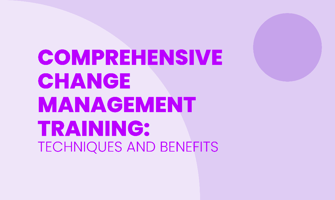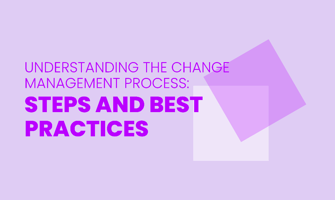Change management training is essential for organizations to handle transitions smoothly and...
Key Change Management Skills Every Leader Needs
Leaders are responsible for setting the tone, cultivating a culture that embraces change, and motivating employees to adapt. Managing change effectively requires more than just implementing new strategies; it demands strong leadership. Without skilled leadership, even the most well-planned change initiatives can falter.
This article provides a comprehensive guide on essential change management skills every leader needs. By mastering these skills, you can become an effective change leader who drives positive outcomes in your organization.
Explore What is Change Management? An Introductory Guide to Understanding Change Management Better.
Impact of Leadership on Change Management
Effective leadership directly impacts employee engagement, adaptability, and overall success in managing organizational culture during times of transformational change. That's why it is said that effective leaders can make or break a change initiative.
Strong leadership boosts employee morale. When employees feel supported, they are more engaged and adaptable during changes. A leader's role in shaping organizational culture is crucial. They influence how open and resilient their teams are to transformational change. Strategic leadership ensures that everyone understands the vision and goals behind the changes.
Resilient leaders help navigate challenges smoothly. They maintain focus and inspire confidence even when things get tough.
Essential Skills Every Leader Needs for Change Management
1. Change Communication
Change communication refers to the process of effectively conveying information about organizational changes to all stakeholders involved. This skill is important for leaders as it ensures that everyone understands the reasons for the change.
Why It Matters
Encourages Engagement: Well-informed employees are more engaged and proactive in the change process.
Reduces Uncertainty & Builds Trust: Transparent communication fosters trust and alleviates fears and uncertainties about the change.
Prevents Misunderstandings: Clear communication reduces resistance to change and prevents misunderstandings that lead to frustration or disengagement.
Techniques to Improve Change Communication
Articulate the Vision Clearly and Consistently: Craft a clear statement that outlines why the change is necessary and how it will benefit both the organization and its employees. Use simple language when explaining your vision so that all stakeholders can easily grasp it.
Utilize Multiple Communication Channels: Different people prefer different methods of receiving information. Combine emails, meetings, intranet updates, social media posts, or even face-to-face conversations to reach all stakeholders effectively.
Encourage Feedback and Open Dialogue: Open dialogue allows concerns from various perspectives that might have been overlooked otherwise. Create anonymous surveys/polls where anyone could voice out opinions without fear & arrange Q&A sessions regularly ensuring no question goes unanswered.
![]()
2. Stakeholder Analysis
Stakeholder analysis is the process of identifying, analyzing, and understanding the interests, influences, and needs of all individuals or groups that are affected by a change initiative. This skill helps leaders to engage the right people and manage their expectations effectively.
Why It Matters
Identifies Key Players: It helps leaders understand who will be impacted by the change and who has the power to influence its success.
Stakeholder Support: Gaining stakeholder support ensures the smoother implementation of changes by turning them into advocates for the change.
Influence Direction: Stakeholders provide valuable insights that can shape better outcomes, addressing concerns before they escalate into larger issues.
Techniques to Improve Stakeholder Analysis
Identify and Categorize Stakeholders: Create a comprehensive stakeholder map that classifies individuals or groups based on their level of influence and interest in the project. Use tools like Excel, PowerPoint, or online platforms to visually plot stakeholders on an interest-influence grid, ensuring a clear understanding of their roles and potential impact.
Engage Stakeholders Early: Initiate contact with key stakeholders at the beginning of the project to gather their input and set clear expectations. Schedule initial meetings to discuss the project's goals and outline what each stakeholder can expect in terms of updates and involvement opportunities, fostering transparency from the start.
Create a Stakeholder Matrix: Develop a stakeholder matrix to prioritize engagement strategies based on their interest and influence. For stakeholders with high influence and high interest, ensure close engagement and active management. For those with high influence but low interest, focus on keeping them satisfied and informed.
3. Impact Assessment
Impact assessment involves evaluating the potential effects of a proposed change on various aspects of an organization. This process helps leaders understand the possible outcomes, both positive and negative, allowing them to make informed decisions and prepare for any challenges that may arise.
Why It Matters
Identifies Potential Risks and Opportunities: Impact assessment helps in recognizing possible risks and opportunities associated with the change.
Informs Strategic Planning: Provides valuable insights for developing strategic plans and ensuring the alignment of change initiatives with organizational goals.
Facilitates Resource Allocation: Impact Assessment ensures that resources are allocated effectively to areas that will be most affected by the change.
Techniques to Improve Impact Assessment
Conduct a Thorough SWOT Analysis: Perform a detailed SWOT analysis to examine the internal and external factors affecting your organization. Involve different teams to discover hidden strengths, weaknesses, opportunities, and threats. This approach ensures a complete understanding of the potential impacts of the change.
2. Use Advanced Predictive Analytics: Implement advanced predictive analytics tools that use machine learning and big data to forecast outcomes more accurately. These tools provide deeper insights into trends and patterns, helping you plan more effectively and manage risks better. Using tools like 180ops can provide leaders with comprehensive data integration and insights, essential for effective impact assessment in change management.
3. Create Detailed Contingency Plans: Develop a risk register that lists identified risks along with their potential impacts. Make detailed action plans for each risk, specifying what needs to be done, who is responsible, and when it should happen. This preparation ensures you can handle unforeseen events with minimal disruption.
![]()
4. Coalition Building
Coalition building is a strategic approach in change management that involves creating alliances and networks of support with key stakeholders, influencers, and team members within the organization to facilitate and sustain organizational change.
This process is dynamic and ongoing, requiring strategic thinking, effective communication, and strong interpersonal skills to successfully gather and maintain support for change initiatives.
Why It Matters
Enhancing Resource Mobilization: Coalitions can help in mobilizing necessary resources, whether they be financial, human, or informational, to support the change initiative.
Facilitating Communication: Coalitions provide channels for effective communication, helping to disseminate information and gather feedback from various parts of the organization.
Driving Momentum: Coalitions create momentum by showing that there is widespread support for the change initiative. This can motivate others to join in.
Techniques to Improve Coalition Building Skill
1. Identify Key Influencers: Use a social network analysis (SNA) to map out relationships and interactions within your organization. This technique helps identify individuals who are central in the network, often those who communicate frequently with many others and are trusted by their peers. Conduct surveys or interviews to gather insights on who employees turn to for advice and support, and observe patterns of informal communication to spot these key influencers.
2. Maintain Ongoing Communication: Keep the lines of communication open with your coalition through regular updates, newsletters, or briefings. Use multiple communication channels, such as email, intranet posts (internal organization network for communication and information sharing), or face-to-face meetings, to ensure everyone stays informed and engaged. Consistent communication helps reinforce the importance of the change and keeping the momentum going.
3. Utilize Conflict Resolution Techniques: Address conflicts early by facilitating discussions that aim for win-win solutions, where all parties feel they have gained something positive. Apply conflict resolution frameworks such as the Thomas-Kilmann Conflict Mode Instrument (TKI), a tool that categorizes different conflict-handling styles (competing, collaborating, compromising, avoiding, and accommodating) to identify the most effective approach for resolving conflicts in various situations.
5. Resistance Management
Resistance management means using strategies and actions to find, address, and reduce pushback against changes in an organization. People can resist change in different ways, from openly opposing it to quietly not following new procedures.
Why It Matters
Ensures Smooth Transitions: Managing resistance early leads to smoother transitions and minimizes disruptions.
Minimizes Disruptions: Effective resistance management helps reduce disruptions to business operations by addressing concerns and pushback.
Sustains Long-term Change: Properly managing resistance ensures that changes are embedded within the organizational culture for lasting success.
Techniques to Improve Resistance Management
1. Identify and Understand the Root Causes: Monitor employee behaviors, attitudes, and performance metrics to detect signs of resistance. Conduct surveys, interviews, and observations to understand the underlying reasons for resistance, whether they are due to lack of information, fear of the unknown, or perceived threats to job security.
2. Develop a Clear Resistance Management Plan: Create a plan that outlines how to address resistance at different levels. This includes identifying key stakeholders, assessing their influence and resistance levels, and developing targeted communication strategies to address their concerns. Ensure the plan includes clear, consistent messaging about the benefits and reasons for the change.
3. Implement a Continuous Feedback Loop: Regularly collect feedback from employees through surveys, suggestion boxes, or meetings. Analyze this feedback to understand ongoing concerns and adjust your approach as needed. Communicate any changes or adjustments made based on the feedback to show that employee input is valued and considered in the change process.
6. Training and Support
Training and support help employees adapt to new processes, technologies, or structural changes, minimizing resistance and promoting a smooth transition.
Why It Matters
Enhances Employee Competence and Confidence: Proper training ensures employees feel capable and confident in their new roles.
Maintains Productivity and Performance: Effective training helps employees adapt quickly, preventing drops in productivity.
Boosts Innovation and Agility: Continuous learning and support encourage employees to think creatively and respond swiftly to new challenges.
![]()
Techniques to Improve Training, Education, and Support
Tailored Training Programs: Customize training sessions to address the specific needs of different employee groups based on their roles and responsibilities. Conduct a needs assessment to identify skill gaps, and design targeted training modules for various departments or teams.
Blended Learning Approach: Combine different learning methods such as in-person training, e-learning, and self-paced modules to cater to diverse learning preferences. Create a mix of online courses, video tutorials, and face-to-face workshops, allowing employees to learn at their own pace and revisit materials as needed.
Establish a Change Network & Accessible Support Teams: Form a network of change champions or advocates within the organization to provide peer support and guidance. Implement help desks, hotlines, or online chat services staffed by knowledgeable support teams available to assist with problems and answer questions.
7. Change Reinforcement
Change reinforcement involves ensuring that new behaviors, processes, and practices are sustained over time after the initial implementation of a change. This step is crucial to prevent employees from slipping back into old habits and to embed the new changes into the organizational culture permanently.
Why It Matters
Prevents Regression: Change reinforcement ensures that employees do not revert to old ways of doing things, which can undermine the change initiative.
Increases Return on Investment: Maximizes the benefits of the change initiative, ensuring that the resources invested yield long-term results.
Solidifies New Behaviors: Helps establish and normalize new practices, making them part of the organizational culture.
Techniques to Improve Change Reinforcement
1. Practice Two-Way Communication: Encourage feedback and open discussions. Create forums, suggestion boxes, or regular town hall meetings where employees can voice concerns and offer suggestions.
2. Reward Employees for Adopting New Practices: Develop incentive programs that reward employees for adopting and promoting new practices. This can include bonuses, awards, or public recognition.
3. Update Policies: Revise organizational policies, procedures, and job descriptions to reflect the new changes, ensuring they are aligned with the new practices.
Conclusion
Leaders who invest time and effort into developing their change management skills will be better equipped to smoothly guide their teams through transitions. Mastering these key skills mentioned above can make a significant difference in navigating organizational changes successfully.
Leaders should focus on honing these abilities regularly. This will not only enhance their capabilities but also ensure they can handle future changes more effectively. Taking proactive steps in developing your change management skills can make a significant difference in how well you lead your team through organizational changes.
Remember that mastering these key skills requires ongoing effort and commitment. By doing so, you'll be better equipped to navigate the complexities of change and drive positive change outcomes for your organizational structure.
FAQs
How can leaders effectively align change management initiatives with organizational goals and employee needs?
Leaders should use strategic thinking to align change goals with organizational objectives. Maintain open communication, regularly updating employees on the progress of the change management plan. Understand and prioritize employee needs on transitional change through feedback.
What key change management skills should leaders develop to enhance both customer psychology and employee experiences during transitions?
Leaders should develop communication, resilience, and positivity skills. Ensure access to necessary resources and support. Understand psychological aspects of change to address resistance and provide emotional support. Stay informed about best practices in change management and new technologies.
How can leaders use strategic thinking, resilience, and resources to effectively manage change initiatives?
Leaders should employ strategic thinking to align change initiatives with organizational goals and plan for long-term success. Demonstrate resilience by maintaining a positive attitude and motivating teams through challenges.
How can change practitioners effectively manage developmental change within a company's internal structures through delegation and resource allocation?
Change leaders should act as change agents by leveraging delegation to distribute responsibilities among team members, ensuring engagement at all levels. Allocate resources strategically, providing necessary training and support.




